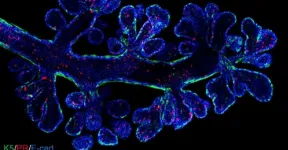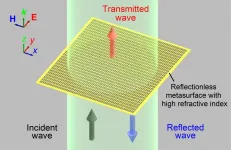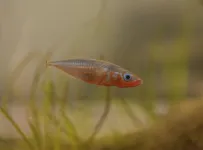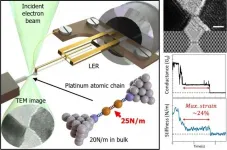New cellular atlas maps out healthy and cancerous breast tissue
2021-05-14
(Press-News.org) Australian researchers have documented the diversity of cells in the human breast, explaining the relationship between healthy breast cells and breast cancer cells.
The research, which relied on expertise spanning from breast cancer biology through to bioinformatics, measured gene expression in single cells taken from healthy women and cancerous breast tissue, including tissue carrying a faulty BRCA1 gene. This enabled the researchers to create an 'RNA atlas' that details the different cells found in these tissues.
The atlas, which was described in EMBO Journal, will enable researchers to better understand the different cell types that constitute breast tissue and how these change during the development of cancer.
The research was undertaken by a team including Dr Bhupinder Pal, Dr Yunshun Chen and Dr François Vaillant, and led by Professor Jane Visvader, Professor Gordon Smyth and Professor Geoff Lindeman.
At a glance
A multidisciplinary team used single-cell transcriptomics to generate an RNA atlas that documents gene expression in different cells in healthy, pre-cancerous and cancerous human breast tissue.
The atlas reveals the changes that occur within the breast during key events, including cancer development and menopause.
The atlas is freely available to researchers around the world and is anticipated to be an important resource for breast cancer research.
Understanding single cells
The human breast is a complex tissue, comprising a wide range of cells including cells specialised for milk production and release, as well as fat cells and immune cells, Professor Visvader said.
"Different types of breast cancer arise from distinct precursor cells. However, breast cancer development can be impacted by other cells within the breast," she said. "This atlas provides a high-resolution view into the various cell types that make up breast tissue in different states and a blueprint for studying changes that lead to breast cancer."
Dr Pal, who is now a laboratory head at the Olivia Newton John Cancer Research Institute, said 'single-cell' technologies enabled the research team to isolate more than 340,000 individual cells from breast tissues donated by women and men and to measure the expression of different genes in these cells.
"Our studies included healthy, pre-cancerous and cancerous tissue, enabling us to study the differences between these tissues," he said
A diverse and changing landscape
The research revealed a wide variety of cell types are present in the human breast, Dr Chen said.
"Complex bioinformatic analysis was crucial for documenting the complex cellular landscape. For example, we found that the composition of a particular subset of cells in the breast was altered by menopause - a period of significant hormonal change within the body," he said.
The research also revealed many changes that occur within breast cancers, said Dr Vaillant.
"All the breast cancer types we studied displayed considerable diversity in their tumour cells, as well as in other cells found within the tumour. In particular, hormone-responsive cancers contained fewer dividing cells of a specific immune type, which could explain why many of these tumours are less responsive to anti-cancer immunotherapies."
A multidisciplinary effort
Single-cell RNA sequencing is a new technology that has revolutionised how researchers can study complex tissues such as the breast said Professor Smyth, joint head of WEHI's Bioinformatics division.
"Bioinformatics was critical for obtaining a global view of the diverse populations of cells within the different breast tissues we studied," he said. "Computational methods enabled the team to detect patterns and differences in gene expression in the different cells within the breast at unprecedented resolution."
Professor Visvader said the RNA atlas was the most comprehensive to-date for the human breast, and provided a framework for understanding the different cell types it can contain.
"This will be an invaluable resource for breast cancer researchers around the world. Our research also has important implications for not only understanding how breast cancers arise but also how cells in the surrounding environment contribute to their development, spread and response to treatment."
The research team would like to acknowledge the important role that tissue donors, the Victorian Cancer Biobank and kConFab played in this study.
The research was supported by the National Health and Medical Research Council, the Victorian Government, the National Breast Cancer Foundation, the Australian Cancer Research Foundation, Ian Potter Foundation, the Michael Heine Family Foundation, and the Qualtrough Cancer Research Fund.
INFORMATION:
[Attachments] See images for this press release:

ELSE PRESS RELEASES FROM THIS DATE:
2021-05-14
Japanese researchers successfully tested reflectionless, highly refractive index metasurface that may eventually be used in practical applications to send, receive, and manipulate light and radio waves in the terahertz waveband (THz). THz is measured in millionths of a meter, known as micrometers. The metasurface, an artificial two-dimensional flat material, was made of micro-sized cut metal wires of silver paste ink placed on both the front and back of a polyimide film. The team, led by Takehito Suzuki, Associate Professor at the Tokyo University of Agriculture and Technology (TUAT) Institute of Engineering, published their findings on April 29, 2021 in Optics Express.
Such flat metasurfaces ...
2021-05-14
Psychology researchers at UC Santa Cruz have found that playing games in virtual reality creates an effect called "time compression," where time goes by faster than you think. Grayson Mullen, who was a cognitive science undergraduate at the time, worked with Psychology Professor Nicolas Davidenko to design an experiment that tested how virtual reality's effects on a game player's sense of time differ from those of conventional monitors. The results are now published in the journal Timing & Time Perception.
Mullen designed a maze game that could be played in both virtual reality and conventional formats, then the research team recruited 41 UC Santa Cruz undergraduate ...
2021-05-14
The COVID-19 pandemic has been shown to have caused a significant strain on the healthcare system and resources in the United States. However, data regarding the impact of the virus on hip fractures, primarily seen in elderly patients, is lacking.
Researchers at Hospital for Special Surgery (HSS) sought to compare characteristics and outcomes of hip fracture patients admitted during the COVID-19 outbreak to patients admitted before the outbreak. They also examined characteristics and outcomes of hip fracture patients with and without the virus. Their findings were presented at the 2021 Spring American Society of Regional Anesthesia and ...
2021-05-14
Interim results of a study conducted by researchers at Hospital for Special Surgery (HSS) suggest that oral tranexamic acid (TXA) is non-inferior to intravenous (IV) TXA in preventing blood loss in total knee and total hip replacement surgery. These findings were presented at the 2021 Spring American Society of Regional Anesthesia and Pain Medicine (ASRA) Annual Meeting.1
Previously available information suggests that oral, IV and topical TXA are all effective at reducing blood loss and drastically reducing blood transfusion rates during and after surgery, but research with direct comparisons for each method is limited.
"TXA in orthopedic surgery has become the standard ...
2021-05-14
While it has been said that the eyes are a window to the soul, a new study shows they could be a means for understanding diseases of the brain. According to new research by scientists at the UCSF Weill Institute for Neurosciences, retinal scans can detect key changes in blood vessels that may provide an early sign of Alzheimer's, while offering important insights into how one of the most common Alzheimer's risk genes contributes to the disease.
"The most prevalent genetic risk for Alzheimer's disease is a variant of the APOE gene, known as APOE4," said lead author Fanny Elahi, MD, PhD. "We still don't fully understand how this variant increases risk of brain degeneration, we just know that it does, and that this risk is modified by sex, race, and lifestyle. "Our ...
2021-05-14
Climate change is exacerbating problems like habitat loss and temperatures swings that have already pushed many animal species to the brink. But can scientists predict which animals will be able to adapt and survive? Using genome sequencing, researchers from McGill University show that some fish, like the threespine stickleback, can adapt very rapidly to extreme seasonal changes. Their findings could help scientists forecast the evolutionary future of these populations.
A popular subject of study among evolutionary ecologists, stickleback are known for their different shapes, sizes, and behaviours - they can even live in both seawater and freshwater, and under a wide range of temperatures. But what ...
2021-05-14
Plants have evolved unique immunity mechanisms that they can activate upon detecting the presence of a pathogen. Interestingly, the presence of some nonpathogenic microorganisms can also prompt a plant to activate its systemic immunity mechanisms, and some studies have shown that pretreating agricultural crops with such "immunity-activating" nonpathogenic microorganisms can leave the crops better prepared to fight off infections from pathogenic microorganisms. In effect, this means that immunity-activating nonpathogenic microorganisms can function like vaccines for plants, providing a low-risk stimulus for the plant's immune system that prepares it for dealing with genuine threats. These are exciting findings for crop scientists because they suggest the ...
2021-05-14
Researchers at UC San Francisco have observed a new feature of neural activity in the hippocampus - the brain's memory hub - that may explain how this vital brain region combines a diverse range of inputs into a multi-layered memories that can later be recalled.
Using a special "micro-grid" recording device developed by colleagues at Lawrence Livermore National Laboratory (LLNL), the UCSF researchers were able to measure hippocampus activity in study participants undergoing surgery to treat severe epilepsy. They discovered that brain waves travel back and forth across this structure, integrating messages ...
2021-05-14
The international scientific community agrees that the latest findings of an FAU research team will revolutionise the entire chemistry of magnesium. The research team have discovered magnesium, which usually has a double positive charge in chemical compounds, in the elemental zero-oxidation state. They have published their ground-breaking findings in the journal Nature.
In the periodic table of elements, magnesium (Mg) is a metal with low electronegativity, which means it does not easily attract electrons but easily loses both the electrons in its outer shell during chemical reactions. It therefore only exists in nature as a compound ...
2021-05-14
Ishikawa, Japan - Today, many well-studied materials in various fields, such as electronics and catalysis, are close to reaching their practical limits. To further improve upon modern technology and outperform state-of-the-art devices, researchers looking for new functional materials have to push the boundaries and explore more extreme cases. A clear example of this is the study of low-dimensional materials, such as monoatomic layers (2D materials) and monoatomic chains (1D materials).
It has been proved time and time again that low-dimensional materials exhibit exotic properties that are absent in their 3D bulk counterparts. For example, monoatomic chains of metals like gold ...
LAST 30 PRESS RELEASES:
[Press-News.org] New cellular atlas maps out healthy and cancerous breast tissue



